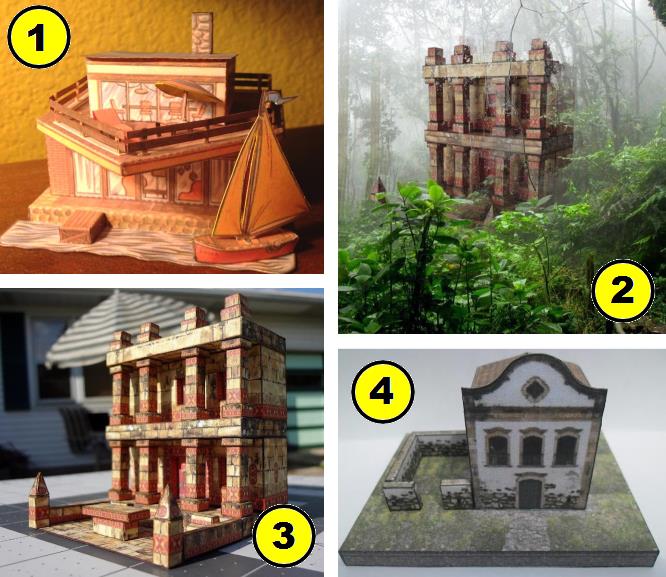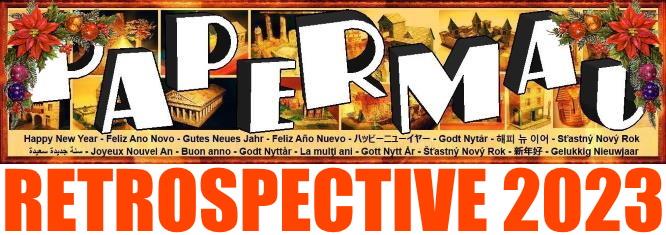Created by Thousand Design agency exclusively for the Eitai neighborhood, here are some paper models, all in 1/600 scale, featuring some landmarks of this picturesque district situated in Tokyo, Japan.
You'll find classic tourist spots of the neighborhood, such as Eitai Bridge and Shusse Inari Shrine, as well as more mundane places like a veterinary clinic, a post office, and even a public restroom near Eitai Bridge.
Shusse Inari Shrine is a Shinto shrine located in Eitai, Tokyo. It is dedicated to Inari, the god of rice, fertility, agriculture, and commerce.
The shrine is known for its hundreds of fox statues, which are messengers of Inari in Japanese mythology.
People often visit the shrine to make wishes related to business success, prosperity, and personal endeavors.
Shusse Inari Shrine holds great cultural and spiritual significance in the Eitai area.
There's also a beautiful papercraft model of the Yakata Ship, which only takes up two printed sheets.
The Yakata Ship is a popular tourist attraction in Tokyo, located in the Shinagawa district, near Eitai.
It is a replica of a cargo transport ship that was common in Japan during the Edo and Meiji periods.
It has been carefully designed to reflect traditional Japanese architecture and construction style, offering visitors an authentic experience of the country's maritime past.
In addition to being a tourist attraction, the Yakata Ship also serves as a floating museum, displaying artifacts and exhibits related to Japan's maritime history.
Eitai is a neighborhood located in the Shinagawa area of Tokyo, Japan. It is known for its blend of tradition and modernity, offering a vibrant and diverse atmosphere for its residents and visitors.
Eitai has a significant industrial history, with many factories and warehouses dating back to the post-war period. Although many of these facilities have been replaced by modern residential and commercial buildings, traces of this industrial past can still be seen in the architecture and atmosphere of the neighborhood.
Despite being a bustling urban area, Eitai offers green spaces and recreational areas for its residents and visitors. Higashi Shinagawa Park, for example, is a popular spot for hiking, picnicking, and outdoor activities, providing a peaceful retreat from the city's hustle and bustle.
Eitai is home to a variety of restaurants and food establishments that reflect Japan's rich culinary culture. From authentic sushi restaurants to cozy izakayas (Japanese pubs), Eitai residents and visitors have a wide range of options to explore and enjoy traditional and contemporary Japanese cuisine.
I'd like to give credit and express my gratitude to my friend John Wagenseil from Paper Modelers forum because it was thanks to his thread "Web Page with Collection of Paper Model Sites" that I found this papercraft.
If you enjoyed this papercraft and want to see more finds like this, I'll leave the link to John's thread because he's always adding new models to his already huge thread, most of which are quite hard to find.
Criados pela agência Thousand Design exclusivamente para o bairro de Eitai, aqui estão alguns modelos de papel, todos na escala 1/600, com alguns pontos turísticos deste pitoresco bairro situado em Tóquio, no Japão.
Você vai encontrar deste pontos turísticos clássicos do bairro, como a Ponte Eitai e o Santuário Shusse Inari e também lugares mais mundanos, como uma clínica veterinária, um posto dos correios e até mesmo um banheiro público da Ponte Eitai.
O Santuário Shusse Inari é um santuário xintoísta localizado em Eitai, Tóquio. Ele é dedicado a Inari, o deus do arroz, da fertilidade, da agricultura e do comércio.
O santuário é conhecido por suas centenas de estátuas de raposas, que são mensageiras de Inari na mitologia japonesa.
As pessoas frequentemente visitam o santuário para fazer pedidos relacionados ao sucesso nos negócios, prosperidade e sucesso em empreendimentos pessoais.
O Santuário Shusse Inari é um local de grande importância cultural e espiritual na área de Eitai.
Ainda há um belo papercraft do Navio Yakata, que ocupa apenas duas folhas impressas.
O Navio Yakata é uma atração turística popular em Tóquio, localizada no distrito de Shinagawa, próximo a Eitai.
Ele é uma réplica de um navio de transporte de carga que era comum no Japão durante os períodos Edo e Meiji.
Ele foi cuidadosamente projetado para refletir a arquitetura e o estilo de construção tradicionais japoneses, oferecendo aos visitantes uma experiência autêntica do passado marítimo do país.
Além de ser uma atração turística, o Navio Yakata também funciona como um museu flutuante, exibindo artefatos e exposições relacionadas à história marítima do Japão.
Eitai é um bairro localizado na área de Shinagawa, em Tóquio, Japão. É uma região conhecida por sua mistura de tradição e modernidade, oferecendo uma atmosfera vibrante e diversificada para seus moradores e visitantes.
Eitai tem uma história industrial significativa, com muitas fábricas e armazéns que remontam ao período pós-guerra. Embora muitas dessas instalações tenham sido substituídas por edifícios residenciais e comerciais modernos, ainda é possível ver vestígios desse passado industrial na arquitetura e na atmosfera do bairro.
Apesar de ser uma área urbana movimentada, Eitai oferece espaços verdes e áreas de recreação para seus residentes e visitantes. O Parque Higashi Shinagawa, por exemplo, é um local popular para caminhadas, piqueniques e atividades ao ar livre, proporcionando um refúgio tranquilo da agitação da cidade.
Eitai abriga uma variedade de restaurantes e estabelecimentos de comida que refletem a rica cultura culinária do Japão. Desde autênticos restaurantes de sushi até acolhedores izakayas (bares japoneses), os moradores e visitantes de Eitai têm uma ampla gama de opções para explorar e desfrutar da gastronomia japonesa tradicional e contemporânea.
Quero deixar aqui os creditos e meus agradecimentos ao meu amigo John Wagenseil, do forum Paper Modelers, pois foi graças a sua thread "Web Page with Collection of Paper Model Sites" que eu cheguei a este papercraft.
Se você gostou deste papercraft e quer ver mais achados como este, vou deixar o link para a thread do John, pois ele está sempre acrescentando novos modelos a sua já enorme thread, na maioria das vezes bem difíceis de encontrar.










































